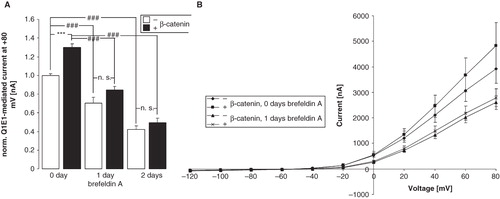Figures & data
Figure 1. Increase in KCNE1/KCNQ1 activity in Xenopus oocytes by β-catenin. (A) Original tracings demonstrating outward currents activated by depolarizations from −120 to + 80 mV in 20 mV steps in Xenopus oocytes injected with water (upper panel), in Xenopus oocytes injected with cRNA encoding KCNE1/KCNQ1 (middle panel) and in Xenopus oocytes injected with cRNA encoding KCNE1/KCNQ1 and β-catenin (lower panel). (B) Arithmetic means ± SEM (n = 7–-24) of the normalized depolarization-induced K + current at + 80 mV in Xenopus oocytes injected with water (left bar) or expressing KCNE1/KCNQ1 without (middle bar) and with (right bar) by β-catenin. ***indicates significant difference from water-injected oocytes (p < 0.001). ### indicates significant difference from the absence of β-catenin (p < 0.001). For normalization, every current at + 80 mV was divided by the average current of only KCNE1/KCNQ1-injected oocytes of the same oocyte batch. (C) Arithmetic means ± SEM of the non-normalized depolarization-induced current as a function of the potential in Xenopus oocytes injected as in B.
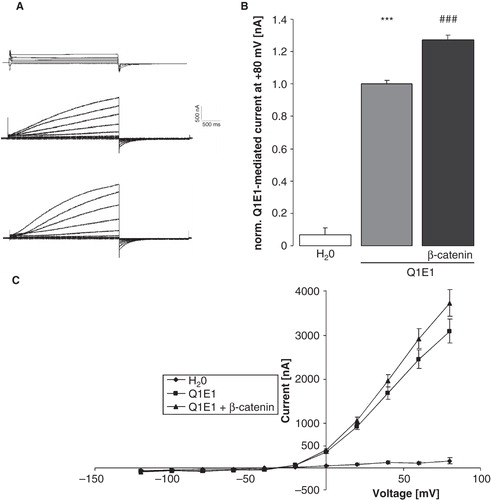
Figure 2. Stimulation of KCNE1/KCNQ1 activity in Xenopus oocytes by β-catenin depends in part on its capability to associate with cadherin. (A) Arithmetic means ± SEM (n = 12–36) of the normalized depolarization-induced K + current at + 80 mV in Xenopus oocytes injected with water (1st bar) or expressing KCNE1/KCNQ1 without (2nd bar) and with (3rd bar) wild-type β-catenin or with (4th bar) β-catenin 1-530 with decrased binding affinity for cadherin. *p < 0.05; ***p < 0.001. For normalization, every current at + 80 mV was divided by the average current of only KCNE1/KCNQ1-expressing oocytes from the same oocyte batch. (B) Arithmetic means ± SEM of the non-normalized depolarization-induced current as a function of the potential in Xenopus oocytes injected as in (A).
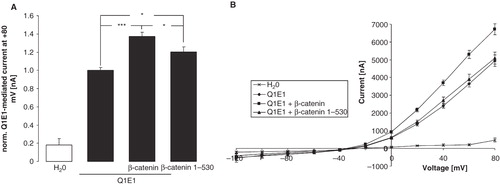
Figure 3. Stimulation of KCNE1/KCNQ1 activity in Xenopus oocytes by β-catenin does not depend on transcription. (A) Arithmetic means ± SEM (n = 22–50) of the normalized depolarization-induced K + current at + 60 mV in Xenopus oocytes injected with water (left bars) or expressing KCNE1/KCNQ1 without (middle bars) and with (right bars) β-catenin in the absence (white bars) and presence (black bars) of 10 μM actinomycin D. ***indicates significant difference from water-injected oocytes (p < 0.001). ### indicates significant difference from the absence of β-catenin (p < 0.001). For normalization, every current at + 60 mV was divided by the average current of only KCNE1/KCNQ1-injected oocytes of the same oocyte batch. (B) Arithmetic means ± SEM of the non-normalized depolarization-induced current as a function of the potential in Xenopus oocytes injected as in A.
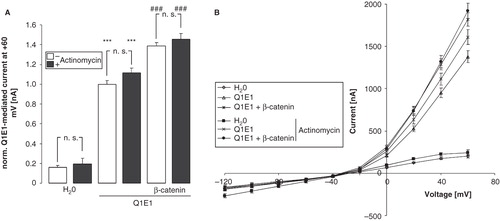
Figure 4. β-catenin enhances the KCNQ1 protein abundance within the plasma membrane of oocytes. (A) Confocal microphotographs of KCNQ1 protein abundance at the cell surface of Xenopus oocytes injected with water (left panel), expressing KCNE1/KCNQ1 alone (middle panel) or expressing ß-catenin together with KCNE1/KCNQ1 (right panel). (B) Arithmetic means ± SEM (n = 51–53) of the normalized KCNE1/KCNQ1-dependent chemiluminescence intensity of Xenopus oocytes injected with water (left bar), expressing KCNE1/KCNQ1 alone (middle bar) or expressing ß-catenin together with KCNE1/KCNQ1 (right bar). ***indicates significant difference from water-injected oocytes (p < 0.001). #indicates significant difference from the absence of β-catenin (p < 0.05). This Figure is reproduced in color in the online version of Molecular Membrane Biology.
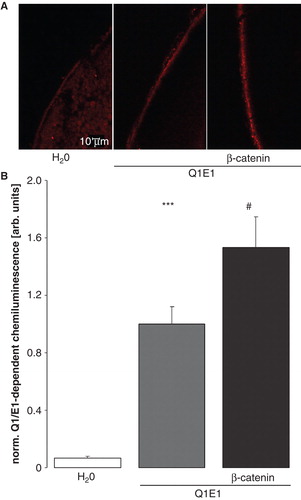
Figure 5. β-catenin enhances the insertion of KCNE1/KCNQ1 into the membrane. (A) Arithmetic means ± SEM (n = 15–29) of the normalized depolarization-induced K + current at + 80 mV in Xenopus oocytes injected with KCNE1/KCNQ1 without (white bars) or with (black bars) additional coexpression of β-catenin and incubated in the absence of brefeldin A (left bars) or incubated in the presence of 5 μM brefeldin A for the last one (middle bars) or two (right bars) days. ###indicates significant difference from the absence of brefeldin A (p < 0.001). ***indicates significant difference from the absence of β-catenin (p < 0.001). For normalization, every current at + 80 mV was divided by the average current of only KCNE1/KCNQ1-expressing oocytes from the same oocyte batch. (B) Arithmetic means ± SEM of the non-normalized depolarization-induced current as a function of the potential in Xenopus oocytes injected as in (A).
